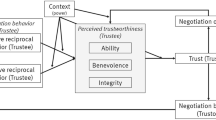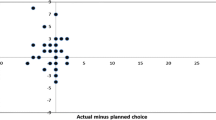Abstract
This paper investigates the measurement of trust transfer in interpersonal contexts. Despite the importance of this topic, little evidence of comparable indicators exists to fill the current gap in knowledge regarding the measurement of interpersonal transference of trust and its reciprocal. We propose a modification of the classical structure of a widely accepted experimental setting for analyzing trust (i.e. a trust game) and build two indexes for the measurement of trust transfer and its reciprocation. Several properties of these indicators are investigated to examine their robustness and accuracy for measuring the transference of interpersonal trust. Furthermore, using data from our own modified trust game, we provide an empirical examination of both indexes. The results show that the existence of a mutually known third party fosters a stronger willingness to achieve cooperative behavior in an anonymous trust game; thus, the transference of interpersonal trust works in both directions of the dyad.



Similar content being viewed by others
Notes
This problem does not affect the validity of the index proposed. However, for the sake of simplicity in interpreting the results, we prefer to restrict the index within the interval \( \left[ {0,1} \right] \).
References
Almond, G. A., & Verba, S. (1963). The civic culture: Political attitudes and democracy in five nations. Princeton, New Jersey: Princeton University Press.
Berg, J., Dickhaut, J., & McCabe, K. (1995). Trust, reciprocity, and social history. Games and Economic Behavior, 10(1), 122–142.
Beugelsdijk, S. (2006). A note on the theory and measurement of trust in explaining differences in economic growth. Cambridge Journal of Economics, 30, 371–387.
Boero, R., Bravo, G., Castellani, M., & Squazzoni, F. (2009). Reputational cues in repeated trust games. Journal of Socio-Economics, 38(6), 871–877.
Brehm, J., & Rahn, W. (1997). Individual-level evidence for the causes and consequences of social capital. American Journal of Political Science, 41, 999–1023.
Camerer, C. (2003). Behavioral game theory: Experiments in strategic interaction. Princeton, NJ: Princeton University Press.
Castelfranchi, C. (2008). Trust and reciprocity: Misunderstandings. International Review of Economics, 55, 45–63.
Coleman, J. S. (1988). Social capital in the creation of human capital. American Journal of Sociology, 94, 95–120.
Coleman, J. S. (1990). Foundations of social theory. Cambridge, MA: Harvard University Press.
Dinesen, P. T. (2010). A note on the measurement of generalized trust of immigrants and natives. Social Indicators Research, 103(1), 169–177.
Doney, P. M., & Cannon, J. P. (1997). An examination of the nature of trust in buyer-seller relationships. Journal of Marketing, 61(2), 35–51.
Doney, P. M., Cannon, J. P., & Mullen, M. R. (1998). Understanding the influence of national culture on the development of trust. Academy of Management Review, 23(3), 601–620.
Easterly, W., Ritzan, J., & Woolcock, M. (2006). Social cohesion, institutions, and growth. Washington, DC: Center for Global Development.
Engle-Warnick, J., & Slonim, R. L. (2004). The evolution of strategies in a repeated trust game. Journal of Economic Behavior & Organization, 55(4), 553–573.
Fukuyama, F. (1995). Trust: The social virtues and the creation of prosperity. New York: The Free Press.
Gambetta, D. (1988). Can we trust? In D. Gambetta (Ed.), Trust: Making and breaking cooperative relations (pp. 213–217). New York: Basil Blackwell.
Glaeser, E. L., Laibson, D. I., Scheinkman, J. A., & Soutter, C. L. (2000). Measuring trust. The Quarterly Journal of Economics, 115(3), 811–846.
Hardin, R. (2002). Trust and trustworthiness. New York: Russell Sage.
Helliwell, J. F., & Putnam, R. D. (1995). Economic growth and social capital in Italy. Eastern Economic Journal, 21(3), 295–307.
Hu, X., Wu, G., Wu, Y., & Zhang, H. (2010). The effects of Web assurance seals on consumers’ initial trust in an online vendor: A functional perspective. Decision Support Systems, 48, 407–418.
Kim, B., Barua, A., & Whinston, A. B. (2002). Virtual field experiments for a digital economy: A new research methodology for exploring an information economy. Decision Support Systems, 32, 215–231.
King-Casas, B., Tomlin, D., Anen, C., Camerer, C., Quartz, S. R., & Montague, P. R. (2005). Getting to know you: Reputation and trust in a two-person economic exchange. Science, 308, 78–83.
Knack, S. (2003). Groups, growth and trust: Cross-country evidence on the Olson and Putnam hypotheses. Public Choice, 117, 341–355.
Koufaris, M., & Hampton-Sosa, W. (2004). The development of initial trust in an online company by new customers. Information & Management, 41(3), 377–397.
Lederman, D., Loayza, N., & Menéndez, A. M. (2002). Violent crime: Does social capital matter? Economic Development and Cultural Change, 50, 509–539.
Lee, J., Park, D. H., & Han, I. (2011). The different effects of online consumer reviews on consumers’ purchase intentions depending on trust in online shopping malls: An advertising perspective. Internet Research, 21(2), 187–206.
Lee, K. C., Wang, I. W., & McKnight, D. H. (2007). Transfer from offline trust to key online perceptions: An empirical study. IEEE Transactions on Engineering Management, 54(4), 729–741.
Lu, Y., Yang, S., Chaung, P. Y. K., & Cao, Y. (2011). Dynamics between the trust transfer process and intention to use mobile payment services: A cross-environment perspective. Information & Management, 48(8), 393–403.
Luhmann, N. (1979). Trust and power: Two works by Niklas Luhmann. Chichester: Wiley.
Lyon, F., Möllering, G., & Saunders, M. N. K. (2012). Handbook of research methods on trust. London: Edward Elgar Publishing.
McKnight, D., Choudhury, V., & Kacmar, C. (2002). Developing and validating trust measures for ecommerce. Information Systems Research, 13(3), 334–359.
Michalos, A. (1990). The impact of trust on business, international security and the quality of life. Journal of Business Ethics, 9(8), 619–638.
Milliman, R. E., & Fugate, D. L. (1988). Using trust-transference as a persuasion technique: An empirical field investigation. The Journal of Personal Selling and Sales Management, 8(2), 1–7.
Misztal, B. A. (1996). Trust in modern societies. Cambridge: Polity.
Möllering, G. (2001). The nature of trust: From Georg Simmel to a theory of expectation, interpretation and suspension. Sociology, 35(2), 403–420.
Myerson, R. B. (1991). Game theory. Cambridge: Harvard University Press.
Nieminen, T., Martelin, T., Koskinen, S., Simpura, J., Alanen, E., Härkänen, T., et al. (2008). Measurement and socio-demographic variation of social capital in a large population-based survey. Social Indicators Research, 85(3), 405–423.
Putnam, R. D. (1993). Making democracy work: Civic tradition in modern Italy. Princeton: Princeton University Press.
Putnam, R. D. (1995). Bowling alone: America’s declining social capital. Journal of Democracy, 6, 65–78.
Putnam, R. D. (2000). Bowling alone: The collapse and revival of American community. New York: Simon and Schuster.
Reeskens, T., & Hooghe, M. (2008). Cross-cultural measurement equivalence of generalized trust. Evidence from the European Social Survey (2002 and 2004). Social Indicators Research, 85(3), 515–532.
Requena, F. (2003). Social capital, satisfaction and quality of life in the workplace. Social Indicators Research, 61(3), 331–360.
Robbins, B. G. (2012). Institutional quality and generalized trust: A nonrecursive causal model. Social Indicators Research, 107(2), 235–258.
Rotenberg, K., Fox, C., Green, S., Ruderman, L., Slater, K., Stevens, K., et al. (2005). Construction and validation of children’s interpersonal trust belief scale. British Journal of Developmental Psychology, 23(2), 271–292.
Rousseau, D. M., Sitkin, S. B., Burt, R. S., & Camerer, C. (1998). Not so different after all: A cross-discipline view of trust. Academy of Management Review, 23(3), 393–404.
Schoorman, F. D., Mayer, R. C., & Davis, J. H. (2007). An integrative model of organizational trust: Past, present, and future. Academy of Management Review, 32(2), 344–354.
Serva, M. A., & Fuller, M. A. (2004). The effects of trustworthiness perceptions on the formation of initial trust: Implications for MIS student teams. Journal of Information Systems Education, 15(4), 383–395.
Serva, M. A., Fuller, M. A., & Mayer, R. C. (2005). The reciprocal nature of trust: A longitudinal study of interacting teams. Journal of Organizational Behavior, 26(6), 625–648.
Simmel, G. (1989). Philosophie des Geldes. Frankfurt: Suhrkamp.
Simmel, G. (1990). The Philosophy of Money. London: Routledge.
Stewart, K. J. (2003). Trust transfer on the World Wide Web. Organization Science, 14(1), 5–17.
Stewart, K. (2006). How hypertext links influence consumer perceptions to build and degrade trust online. Journal of Management Information Systems, 23(1), 183–210.
Stiglitz, J. E., Sen, A., & Fitoussi, J. P. (2009). Report by the Commission on the measurement of economic performance and social progress. Paris. http://www.stiglitz-sen-fitoussi.fr/documents/rapport_anglais.pdf.
Stiglitz, J. E., Sen, A., & Fitoussi, J. P. (2010). Mismeasuring our lives: Why GDP doesn’t add up?. New York: The New Press.
Tan, S. J., & Tambyah, S. K. (2011). Generalized trust and trust in institutions in Confucian Asia. Social Indicators Research, 103(3), 357–377.
Tokuda, Y., & Inoguchi, T. (2008). Interpersonal mistrust and unhappiness among Japanese people. Social Indicators Research, 89(2), 349–360.
Tsai, M. C., Laczko, L., & Bjørnskov, C. (2011). Social diversity, institutions and trust: A cross-national analysis. Social Indicators Research, 101(3), 305–322.
Tyler, T., & Kramer, R. (1996). Whither trust? In R. Kramer & T. Tyler (Eds.), Trust in organizations (pp. 1–16). Thousand Oaks, CA: Sage.
Uzzi, B. (1996). The sources and consequences of embeddedness for the economic performance of organizations: The network effect. American Sociological Review, 61(4), 674–698.
van der Horst, M., & Coffé, H. (2012). How friendship network characteristics influence subjective well-being. Social Indicators Research, 107(3), 509–529.
Vidotto, G., Vicentini, M., Argentero, P., & Bromiley, P. (2008). Assessment of organizational trust: Italian adaptation and factorial validity of the organizational trust inventory. Social Indicators Research, 88(3), 563–575.
Williamson, O. E. (1993). Calculativeness, trust, and economic organization. Journal of Law and Economics, 34, 453–502.
Zimmer, J. C., Arsal, R., Al-Marzouq, M., Moore, D., & Grover, V. (2010). Knowing your customers: Using a reciprocal relationship to enhance voluntary information disclosure. Decision Support Systems, 48, 395–406.
Zucker, L. G. (1986). Production of trust: Institutional sources of economic structure, 1840–1920. Research in Organizational Behavior, 8, 53–111.
Acknowledgments
The authors are thankful for the valuable comments that were provided by two anonymous referees and for the financial support received from the Spanish Ministry of Education (project ECO2010-20483) and the Regional Government of Andalusia (project SEJ-3765).
Author information
Authors and Affiliations
Corresponding author
Appendix: The process of building the trust transfer reciprocation index
Appendix: The process of building the trust transfer reciprocation index
We establish the following notation:
-
\( y_{2}^{j} \): trust received by the β-type k(j)-trustee from the j-trustor
-
\( y_{12}^{j} \): trust placed by the j-trustor to the β-type k(j)-trustee
-
\( y_{21}^{j} \): trust returned by the β-type k(j)-trustee to the j-trustor
We specify that trust transfer reciprocity is maximized in a given period when a trustor and a β-type trustee trust one another in the same proportion of total trust that each has in that period.
Because the initial endowment of the trustor in our trust game is M j , the proportion of trust placed by the j-trustor in the β-type k(j)-trustee is \( \frac{{y_{12}^{j} }}{{M_{j} }} \).
Moreover, because the trust received by the β-type k(j)-trustee is \( y_{2}^{j} = my_{12}^{j} \), the proportion of trust returned to the j-trustor to the β-type k(j)-trustee is: \( \frac{{y_{21}^{j} }}{{my_{12}^{j} }} \).
According to our definition of trust transfer reciprocation, both proportions must be (at least) equal for trust transfer reciprocation to be maximized. Therefore, \( \frac{{y_{12}^{j} }}{{M_{j} }} = \frac{{y_{21}^{j} }}{{my_{12}^{j} }} \) if and only if \( \frac{{M_{j} y_{21}^{j} }}{{m\left( {y_{12}^{j} } \right)^{2} }} = 1 \).
Henceforth, we obtain the following expression:
Nonetheless, this index is not bounded within the interval \( \left[ {0,1} \right] \).Footnote 1 To solve this equation, we propose the following expression:
Furthermore, the above expression is an undefined problem if the denominator is zero. Because the multiplier must reflect a return on an investment and is, by definition, positive, the denominator of the above expression reaches zero if and only if the trust placed by the j-trustor in the β-type k(j)-trustee is zero (i.e. \( y_{12}^{j} = 0 \)). Hence, to avoid such a possibility, we make the following adjustment:
\( TTR_{21}^{j} = \min \left\{ {\frac{{M_{j} y_{21}^{j} }}{{\max \left\{ {m\left( {y_{12}^{j} } \right)^{2} ,1} \right\}}},1} \right\} \).
Rights and permissions
About this article
Cite this article
Delgado-Márquez, B.L., Hurtado-Torres, N.E. & Aragón-Correa, J.A. On the Measurement of Interpersonal Trust Transfer: Proposal of Indexes. Soc Indic Res 113, 433–449 (2013). https://doi.org/10.1007/s11205-012-0103-z
Accepted:
Published:
Issue Date:
DOI: https://doi.org/10.1007/s11205-012-0103-z




